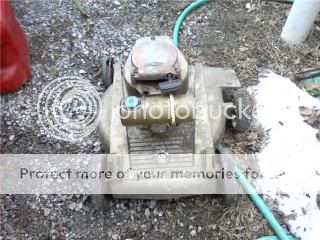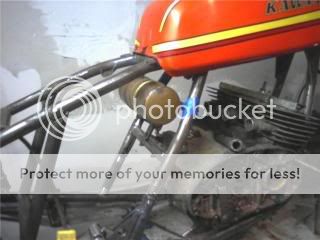We noticed you are blocking ads. DO THE TON only works with community supporters. Most are active members of the site with small businesses. Please consider disabling your ad blocking tool and checking out the businesses that help keep our site up and free.
You are using an out of date browser. It may not display this or other websites correctly.
You should upgrade or use an alternative browser.
You should upgrade or use an alternative browser.
removing oil pump from two stroke engine
- Thread starter samp615
- Start date
stroker crazy
crazy as a fox
Running pre-mix in a two-stroke is fine when you're racing but not really a good idea otherwise. In the pits you can accurately measure the amount of oil necessary and mix it thoroughly in the petrol before filling the tank. Unless you carry a mixing container with you when you're on the on the road any additional fuel added is going to have a possibly inadequate, unevenly mixed percentage of oil in it.
An oil pump is probably the safest, least hassle method of providing critical lubrication to the motor.
Crazy
An oil pump is probably the safest, least hassle method of providing critical lubrication to the motor.
Crazy
AlphaDogChoppers
Science is true whether you believe in it or not.
I've done it with fine results. The one thing you have to be careful about is how the crank bearings get lubricated. There is often kind of a shield at the main bearings that would prevent oil from getting to them. That has to be modified to expose the bearing to lubrication. I always ran Castrol R30 at 32:1.
Advantages? It removes the oil tank which weighs maybe 4 oz. <G>
You can't count the weight savings of the oil in the tank, because you now carry the oil in the gas tank.
Would I do it again on a race bike or off-road only bike? Probably not. Would I do it on a street legal bike? No way.
Advantages? It removes the oil tank which weighs maybe 4 oz. <G>
You can't count the weight savings of the oil in the tank, because you now carry the oil in the gas tank.
Would I do it again on a race bike or off-road only bike? Probably not. Would I do it on a street legal bike? No way.
650hardtail
Been Around the Block
usually the pumps are reliable...id never consider pulling the pump on a street bike
(even at 40 yrs...still going strong )

(even at 40 yrs...still going strong )

Uncle Billy
Luck: When preparation meets opportunity.
Using premix, the amount of lubrication is determined by the throttle alone; using the pump, the lubrication is determined by the throttle setting AND the rpm.
The oil pump insures that there's adequate lubrication for the bottom end and pistons when the motor is at high revs with the throttle closed, like slowing from a high speed on the highway to make a slow turnoff or stop for a traffic signal. Downshifting a 2-stroke for engine braking is useless- there isn't any- and hard on the motor- the revs go high with the throttle closed; oil pumps help keep the motor unstuck when someone who hasn't learned how to live with a 2-stroke is at the controls and does that. Downshifting keeps the transmission in the right gear for the bike's diminishing speed, but letting the clutch out ought to be done only when accelerating again from a slow speed after having selected the correct lower gears as the road speed diminished so as to be ready when the situation warranted getting back on the gas again.
Modern 2-stroke lube is such a good lubricant that some of this problem is alleviated, but the motor can still be starved for oil when you close the throttle at high speed using pre-mix. Richer idle jets or idle needle valve setting and enlightened throttle management can prevent seizing, but it's even more sensible to keep a finger or 2 on the clutch lever at all times when riding a 2-stroke that originally had an oil pump but it was removed. Actually that's a good idea anytime, on a 2-stroke, especially one that's been modified in some way to run hotter- freer air cleaners, for example, or using an aftermarket tuned exhaust system.
The mass of air cooled two-stroke cylinders is unavoidably asymmetrically distributed due to the bypass ports, so they change shape a little when they expand with the heat of running. The bore must be a circle in cross section when it's hot, so it has to be machined a little oversized when it's cold and thus not precisely round, which is why big-bore 2-strokes rattle and clang a lot when they're first started- the piston is round, the bore is not but it's large enough so the piston can move freely, loose enough to "slap" until the cylinder is up to operating temperature and so the bore is therefore closer to being round. In the past, piston-to-bore clearances were larger in 2-strokes than they were for 4-strokes to help prevent oil starved seizing; oil pumps helped make that somewhat unnecessary which lessened the chance of seizing and made the motors mechanically quieter and less annoying. Such altered motors are more susceptible to oiling problems than those designed out front to run premix because their piston-to-bore clearances are a little tighter. Of course, liquid-cooled motors avoid a lot of these issues since the range of their operating temperature is much narrower.
You can get away with taking the pump off and using premix, but there are a lot of factors involved. I'd keep the pump. In fact I've kept the pump on all the 2-strokes I own except one- that's 4 out of 5.
The oil pump insures that there's adequate lubrication for the bottom end and pistons when the motor is at high revs with the throttle closed, like slowing from a high speed on the highway to make a slow turnoff or stop for a traffic signal. Downshifting a 2-stroke for engine braking is useless- there isn't any- and hard on the motor- the revs go high with the throttle closed; oil pumps help keep the motor unstuck when someone who hasn't learned how to live with a 2-stroke is at the controls and does that. Downshifting keeps the transmission in the right gear for the bike's diminishing speed, but letting the clutch out ought to be done only when accelerating again from a slow speed after having selected the correct lower gears as the road speed diminished so as to be ready when the situation warranted getting back on the gas again.
Modern 2-stroke lube is such a good lubricant that some of this problem is alleviated, but the motor can still be starved for oil when you close the throttle at high speed using pre-mix. Richer idle jets or idle needle valve setting and enlightened throttle management can prevent seizing, but it's even more sensible to keep a finger or 2 on the clutch lever at all times when riding a 2-stroke that originally had an oil pump but it was removed. Actually that's a good idea anytime, on a 2-stroke, especially one that's been modified in some way to run hotter- freer air cleaners, for example, or using an aftermarket tuned exhaust system.
The mass of air cooled two-stroke cylinders is unavoidably asymmetrically distributed due to the bypass ports, so they change shape a little when they expand with the heat of running. The bore must be a circle in cross section when it's hot, so it has to be machined a little oversized when it's cold and thus not precisely round, which is why big-bore 2-strokes rattle and clang a lot when they're first started- the piston is round, the bore is not but it's large enough so the piston can move freely, loose enough to "slap" until the cylinder is up to operating temperature and so the bore is therefore closer to being round. In the past, piston-to-bore clearances were larger in 2-strokes than they were for 4-strokes to help prevent oil starved seizing; oil pumps helped make that somewhat unnecessary which lessened the chance of seizing and made the motors mechanically quieter and less annoying. Such altered motors are more susceptible to oiling problems than those designed out front to run premix because their piston-to-bore clearances are a little tighter. Of course, liquid-cooled motors avoid a lot of these issues since the range of their operating temperature is much narrower.
You can get away with taking the pump off and using premix, but there are a lot of factors involved. I'd keep the pump. In fact I've kept the pump on all the 2-strokes I own except one- that's 4 out of 5.
AlphaDogChoppers
Science is true whether you believe in it or not.
I'll just add to your excellent post that there are some two-strokes that disengage the oil pump when the clutch is pulled in. The Suzuki 500 Titan was one such bike. Not a good idea to hold the clutch in for very long.
crazypj
Split personality, I fake being smart
Just a thought, (which could be/was an issue on racing bikes, particularly Enduro's)
You have throttle closed on downhill, engine gets very little lubrication with throttle closed when you use pre-mix, when you 'get on the gas' it can (and does) 'pick up' when piston 'sticks' slightly in cylinder.
It also accelerates main bearing wear, particularly if you cheanged down and rpm was relatively high.
If bike was designed for an oil pump and your using it on the street, there is no good reason to remove it.
Most older Suzuki's need a full crank strip to remove oil slingers plus crankcase mods to get oil to main bearings and big end(s)
I just noticed 'uncle billy' pretty much said exactly the same thing 8)
You have throttle closed on downhill, engine gets very little lubrication with throttle closed when you use pre-mix, when you 'get on the gas' it can (and does) 'pick up' when piston 'sticks' slightly in cylinder.
It also accelerates main bearing wear, particularly if you cheanged down and rpm was relatively high.
If bike was designed for an oil pump and your using it on the street, there is no good reason to remove it.
Most older Suzuki's need a full crank strip to remove oil slingers plus crankcase mods to get oil to main bearings and big end(s)
I just noticed 'uncle billy' pretty much said exactly the same thing 8)
MotorbikeBruno
Over 1,000 Posts
Thanks for asking this question samp615. And thanks to you all for answering it so nicely. I just picked up my first "enduro" which is a 1977 DT100D PJ has already got me on track to get it running. I never really knew much of anything, and now I feel a hell of a lot more confident in riding the thing! The knowledge on here is unbelievable. So, I say thanks again. And Merry x-mas since it's coming up so quickly!
Bruno
Bruno
In my other thread I am building a tracker out of a KE125. I like to have only what is necessary on the bike and was curious if it was necessary.
The main reason however is because I am a little nervous when I have to rebuild the bike that I will improperly attach the throttle line and oil pump line and not have them synced up right.
The main reason however is because I am a little nervous when I have to rebuild the bike that I will improperly attach the throttle line and oil pump line and not have them synced up right.
650hardtail
Been Around the Block
synching em is simple..if you reuse the stock tank FLUSH the tank and line to the pump..
the old oil can turn into primordial ooze if its sat for years...
if you want to do a new external oil tank..heres what i did


the old oil can turn into primordial ooze if its sat for years...
if you want to do a new external oil tank..heres what i did


We race 2 strokes and have had a slew of 2 stroke street bikes and for the racers, premix is what we do and as someone posted above can get the right ratios that work on a particular motor. Oil and fuel do tend to separate out when left for more than a day and many two strokes have oil slingers on the main bearings which helps pumped oil to get to the big ends, but stops premix from getting there. Not a happy outcome.
For street bikes it's oil pumps all the time every time. If I don't have the original oil tank or want to move it, another one goes in there somewhere.
For street bikes it's oil pumps all the time every time. If I don't have the original oil tank or want to move it, another one goes in there somewhere.




